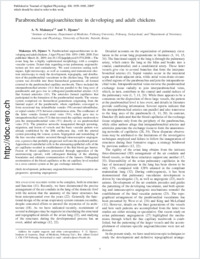Parabronchial angioarchitecture in developing and adult chickens
- Makanya, Andrew N. Institute of Anatomy, Department of Medicine, University of Fribourg, Switzerland - Department of Veterinary, Anatomy and Physiology, University of Nairobi, Kenya
- Djonov, Valentin Institute of Anatomy, Department of Medicine, University of Fribourg, Switzerland
-
26.03.2009
Published in:
- Journal of Applied Physiology. - 2009, vol. 106, p. 1959-1969
English
The avian lung has a highly sophisticated morphology with a complex vascular system. Extant data regarding avian pulmonary angioarchitecture are few and contradictory. We used corrosion casting techniques, light microscopy, as well as scanning and transmission electron microscopy to study the development, topography, and distribution of the parabronchial vasculature in the chicken lung. The arterial system was divisible into three hierarchical generations, all formed external to the parabronchial capillary meshwork. These included the interparabronchial arteries (A1) that ran parallel to the long axes of parabronchi and gave rise to orthogonal parabronchial arteries (A2) that formed arterioles (A3). The arterioles formed capillaries that participated in the formation of the parabronchial mantle. The venous system comprised six hierarchical generations originating from the luminal aspect of the parabronchi, where capillaries converged to form occasional tiny infundibular venules (V6) around infundibulae, or septal venules (V5) between conterminous atria. The confluence of the latter venules formed atrial veins (V4), which gave rise to intraparabronchial veins (V3) that traversed the capillary meshwork to join the interparabronchial veins (V1) directly or via parabronchial veins (V2). The primitive networks inaugurated through sprouting, migration, and fusion of vessels and the basic vascular pattern was already established by the 20th embryonic day, with the arterial system preceding the venous system. Segregation and remodeling of the fine vascular entities occurred through intussusceptive angiogenesis, a process that probably progressed well into the posthatch period. Apposition of endothelial cells to the attenuating epithelial cells of the air capillaries resulted in establishment of the thin blood-gas barrier. Fusion of blood capillaries proceeded through apposition of the anastomosing sprouts, with subsequent thinning of the abutting boundaries and ultimate communication of the lumens. Orthogonal reorientation of the blood capillaries at the air capillary level resulted in a cross-current system at the gas exchange interface.
- Faculty
- Faculté des sciences et de médecine
- Department
- Département de Médecine
- Language
-
- English
- Classification
- Biological sciences
- License
- License undefined
- Identifiers
-
- RERO DOC 12245
- DOI 10.1152/japplphysiol.91570.2008
- Persistent URL
- https://folia.unifr.ch/unifr/documents/301182
Statistics
Document views: 64
File downloads:
- djonov_pad.pdf: 203
